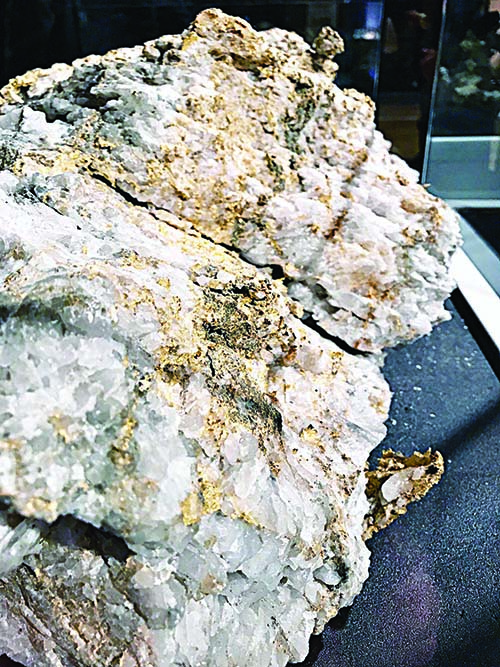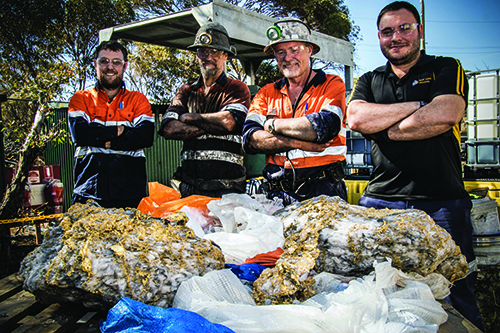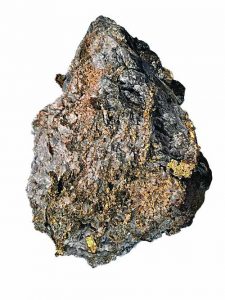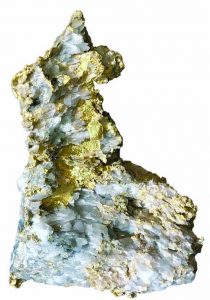
By Bob Jones
Deep in the Southwestern Australia outback is the Beta Hunt nickel mine. It is located in the Kambolda district, and is owned and operated by RNC Minerals. For years the mine has produced significant quantities of nickel-metal ore and gold as a second ore.
The mine is about 400 miles (630 km) from Perth in what is known as the Kalgoorlie Goldfields, which since the late 1800s has yielded millions of dollars in gold. When I visited Kalgoorlie, I was impressed by its lovely Victorian-style buildings.
Discovery of the Deposit
The Beta Hunt nickel deposit was discovered in 1966 in the Norseman-Wiluna greenstone belt rich in many metal deposits. The host rocks at the Beta Hunt mine consist of ultramafic rocks with talc-carbonate and serpentine formations. The ores occur in more or less parallel veins rich in nickel with minor amounts of recoverable gold.
Nickel, number 28 on the Periodic Table of Elements, is important in steelmaking and has many uses beyond stainless steel and armor plate production. It is a minor component in some foods and important in the electrical industry for making batteries and household items like toasters and ovens.
Little did the miners at the Beta Hunt deposit realize while mining nickel ore in 2018 they would suddenly be converted from being nickel miners to gold miners. It started on Father’s Day 2018 when a quartz vein rich in gold was encountered during mining. Examples of gold suitable as specimens were recovered. But that find only proved to be a preview of what was to become in September of that year. Working the same vein at the 1600-foot level, a real golden treasure, some call it a miracle, was revealed.
The miracle discovery happened when miner Henry Dole, was doing his job of drilling and blasting the vein when the blast he set off exposed an amazing sight once the dust and gases cleared. Instead of just another pile of fractured and broken nickel ore, he saw a huge pile of broken white quartz with bright yellow crystalline gold sticking out! He had exposed a white quartz vein loaded with native gold, a true miracle.

Bringing the Lode to the Surface
As one would expect, the miners set about bringing the rich gold lode to the surface. Huge chunks of gold shot through white quartz were carried away and hoisted out. Some pieces were two and three feet across, and it took two or three men to carry and prepare them for hoisting. The largest piece weighed in at nearly 200 pounds with gold aplenty, while another big chunk weighed in at 132 pounds. It took four days to clean out the quartz vein. The miners estimated the gold-rich area they had mined measured about 10 by 10 feet.
The find caused an immense stir in the camp as officials tried to figure out how much gold they had and what to do with it. Should the gold ore go to the crusher or be saved as specimen gold? The Beta Hunt RNC officials showed great foresight. Rather than destroying these glittering treasures, they chose to preserve them as specimens. This meant the specimens had to be prepared for the museum and specimen market so folks could enjoy them for centuries to come. Preparation meant that as much quartz as possible had to be removed to expose as much gold as possible.
As for values, it was possible to determine the gold content of the quartz gold, but this was complicated by the sheer size of some of the quartz pieces. One commonly used method is to x-ray the specimen since the metallic gold would show up as a black image in a gray rock background. But mines don’t make a practice of having x-rays machines on the premises. The next best method is to use specific gravity testing to get a close estimate of gold content. This technique could be done right in the mine. Each specimen was checked by specific gravity testing and estimates of the gold content were made.
The totals were breathtaking as the gold retrieved from that 10 by 10-foot area pocket was estimated to contain something around 9,000 ounces of the yellow metal. Even at a conservative estimate, that’s not bad for four days’ work. Just using the spot price of gold as a guide they estimated they had something like $15 million in gold on their hands (see the accompanying chart). Security at the mine was immediately increased. This answered the question of smelter or specimen market. The latter was an obvious choice.
Greek Gravity History
If you are not familiar with the specific gravity test, it was the brainchild of the Greek Archimedes who was born in Syracuse, Sicily, in 287 BCE. As a brilliant mathematician, he worked on many problems, one of which resulted in his discovery of specific gravity testing.
Archimedes was asked to determine if a gold crown made for King Hebron was pure gold or if the maker substituted silver for some of the gold and made a cheaper gold-silver alloy crown. The problem stumped Archimedes, but legend has it, one day while taking a bath, he realized the amount of water his body displaced might be the solution.
According to legend, he leaped out of the bath and ran naked down the street shouting “Eureka, I found it!” That seems unlikely, but what he did discover was by submerging an object in water, the amount of water displaced sets up a ratio between the actual weight of the object in the air and the weight of the water displaced.
The purity of the gold caused minor variations in the results, but this is still an easy way to check what we call the specific gravity of an object.
When the folks at Beta Hunt started checking the quartz-gold specimens, they were, to say the least, pleased! The nearly 200-pound piece, which required three or four men to lift and carry, was checked and estimated to hold about 2,300 ounces of gold. Now, I’m no mathematician, but by multiplying that number by the current spot price of gold, which has been fluctuating between $1,200 and $1,500 an ounce, I get an amazing result. The Beta Hunt staff also calculated the 132-pound quartz piece to hold 1,600 ounces of gold.
Single Super-Size or A Bunch of Chunks

But now that they knew the value of the gold, a second problem arose. Was the gold all one piece or just a bunch of small chunks scattered throughout the quartz? The larger the gold piece is in the quartz, the rarer and more valuable a display specimen it would be. Did they only have a lot of small specimens, or was the gold in each specimen connected? By removing the quartz was the gold going to fall out in pieces, or could it be exposed as a single spectacular array of the yellow metal?
Did the bigger specimens contain a few big museum-size pieces? One could send the specimens to the crusher and retrieve the thousands of ounces of gold and melt it into bars. Doing that would be easy, but would make every mineral collector and museum curator, including this writer, cringe and holler, NO!
Fortunately, cool heads at Beta Hunt-RNC prevailed and as it was realized that by submitting each specimen to a preparation laboratory, much of the quartz could be removed exposing as much of the gold as possible, which would make each specimen more saleable and valuable while creating something to behold when on display! But that raised another problem.
One can’t see inside the quartz to find where the gold is or if all the gold is connected as one huge piece or is many disconnected small gold fragments. This is vital information so when one starts removing the quartz, the gold would stay together or would simply fall apart into smaller specimens as the quartz was removed. Ideally, the gold should be preserved as one spectacular piece.
To be sure, one of the larger specimens was finally shipped out to be x-rayed. Surprise, X-raying didn’t work. Instead of getting an x-ray picture showing the quartz as gray and gold as black images, the resulting picture was virtually all black. Eureka! Gold was everywhere! Now, what does one do? Not to worry.
There is another far less definitive method to determine if the gold is all connected, or a bunch of random fragments locked in and sticking out of the quartz. It is called an electrical conductivity test. When I worked as a car mechanic, we used two battery-powered electrical probes to find breaks in the wiring. That also works on hidden gold.
By touching gold sticking out of quartz, in two different exposed places, it’s possible to determine if they are connected. From that, you gradually draw a rough map of the interior of the quartz, which will help guide the expert in specimen preparation to start chipping, grinding or sandblasting away the quartz. This is all very time consuming but is a useful last resort in such instances.
Marketing the Gold
Once the decision was made to sell the gold as specimens, rather than smashing it into smelter feed, the company had a final problem of shipping the gold to the specimen lab in Denver for preparation by experts. As of this writing, the preparation work has finally begun, and we will report as things progress.
Another question to consider: once prepared for sale, how will these amazing

gold specimens be marketed? The mining company certainly was not equipped to get into the specimen sales market. So, RNC Beta Hunt decided to choose a couple of reputable mineral experts to do that for them. One well-known dealer company chosen to market the gold in quartz collector specimens is Unique Minerals. This group is highly regarded and regularly attend all of the major shows. Unique Minerals was also of great help in supplying information, data, and photos to this writer as I wrote this article. Maybe that’s because Unique Minerals is owned by Marc Miterman and my son Evan Jones, whom many readers know. A second dealer, Dr. Peter Megaw, was also chosen to represent the company.
Many people know Peter as the chairman of the Special Exhibit at the famous Tucson Gem and Mineral Show™. Be sure and look for any of these fellows as you attend the major shows in 2020, and enjoy the opportunity to view specimens from the amazing Father’s Day miracle of 2018.
We concluded this three-part series on gold in the March 2020 issue, as we describe the wonderful collection of crystallized gold from the Breckenridge area of Colorado in the Denver Museum of Nature and Science. You’ll learn about “Tom’s Baby” and the story of Colorado’s most unusual gold specimen.














